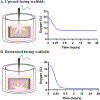Crypt-Villus Scaffold Architecture for Bioengineering Functional Human Intestinal Epithelium
- PMID: 36191009
- PMCID: PMC10379436
- DOI: 10.1021/acsbiomaterials.2c00851
Crypt-Villus Scaffold Architecture for Bioengineering Functional Human Intestinal Epithelium
Abstract
Crypt-villus architecture in the small intestine is crucial for the structural integrity of the intestinal epithelium and maintenance of gut homeostasis. We utilized three-dimensional (3D) printing and inverse molding techniques to form three-dimensional (3D) spongy scaffold systems that resemble the intestinal crypt-villus microarchitecture. The scaffolds consist of silk fibroin protein with curved lumens with rows of protruding villi with invaginating crypts to generate the architecture. Intestinal cell (Caco-2, HT29-MTX) attachment and growth, as well as long-term culture support were demonstrated with cell polarization and tissue barrier properties compared to two-dimensional (2D) Transwell culture controls. Further, physiologically relevant oxygen gradients were generated in the 3D system. The various advantages of this system may be ascribed to the more physiologically relevant 3D environment, offering a system for the exploration of disease pathogenesis, host-microbiome interactions, and therapeutic discovery.
Keywords: 3D printing; crypts; intestine tissue; oxygen profile; silk; tissue engineering; villi.
Conflict of interest statement
The authors declare no competing financial interest.
Figures






Similar articles
-
A microengineered collagen scaffold for generating a polarized crypt-villus architecture of human small intestinal epithelium.Biomaterials. 2017 Jun;128:44-55. doi: 10.1016/j.biomaterials.2017.03.005. Epub 2017 Mar 6. Biomaterials. 2017. PMID: 28288348 Free PMC article.
-
Fabrication of 3D scaffolds reproducing intestinal epithelium topography by high-resolution 3D stereolithography.Biomaterials. 2019 Nov;221:119404. doi: 10.1016/j.biomaterials.2019.119404. Epub 2019 Aug 5. Biomaterials. 2019. PMID: 31419651
-
Use of hydrogel scaffolds to develop an in vitro 3D culture model of human intestinal epithelium.Acta Biomater. 2017 Oct 15;62:128-143. doi: 10.1016/j.actbio.2017.08.035. Epub 2017 Aug 30. Acta Biomater. 2017. PMID: 28859901
-
3D in vitro morphogenesis of human intestinal epithelium in a gut-on-a-chip or a hybrid chip with a cell culture insert.Nat Protoc. 2022 Mar;17(3):910-939. doi: 10.1038/s41596-021-00674-3. Epub 2022 Feb 2. Nat Protoc. 2022. PMID: 35110737 Free PMC article. Review.
-
Tissue Engineering Laboratory Models of the Small Intestine.Tissue Eng Part B Rev. 2018 Apr;24(2):98-111. doi: 10.1089/ten.teb.2017.0276. Epub 2017 Dec 5. Tissue Eng Part B Rev. 2018. PMID: 28922991 Review.
Cited by
-
Advancements and Challenges in Modeling Mechanobiology in Intestinal Host-Microbiota Interaction.ACS Appl Mater Interfaces. 2025 Jun 4;17(22):31698-31713. doi: 10.1021/acsami.4c20961. Epub 2025 May 18. ACS Appl Mater Interfaces. 2025. PMID: 40382722 Review.
-
Fibroblasts modulate epithelial cell behavior within the proliferative niche and differentiated cell zone within a human colonic crypt model.Front Bioeng Biotechnol. 2024 Dec 16;12:1506976. doi: 10.3389/fbioe.2024.1506976. eCollection 2024. Front Bioeng Biotechnol. 2024. PMID: 39737053 Free PMC article.
-
Biomimetic culture substrates for modelling homeostatic intestinal epithelium in vitro.Nat Commun. 2025 May 3;16(1):4120. doi: 10.1038/s41467-025-59459-x. Nat Commun. 2025. PMID: 40316543 Free PMC article.
-
Challenges in Permeability Assessment for Oral Drug Product Development.Pharmaceutics. 2023 Sep 28;15(10):2397. doi: 10.3390/pharmaceutics15102397. Pharmaceutics. 2023. PMID: 37896157 Free PMC article. Review.
-
An In Vitro Cell Model of Intestinal Barrier Function Using a Low-Cost 3D-Printed Transwell Device and Paper-Based Cell Membrane.Int J Mol Sci. 2025 Mar 12;26(6):2524. doi: 10.3390/ijms26062524. Int J Mol Sci. 2025. PMID: 40141167 Free PMC article.
References
-
- Halm D; Halm S Secretagogue response of goblet cells and columnar cells in human colonic crypts, American journal of physiology. Cell Physiol. 2000, 278, C212–C233. - PubMed
-
- Castaño AG; Garcia-Diaz M; Torras N; Altay G; Comelles J; Martinez E Dynamic photopolymerization produces complex microstructures on hydrogels in a moldless approach to generate a 3D intestinal tissue model. Biofabrication 2019, 11, No. 025007. - PubMed
Publication types
MeSH terms
Grants and funding
LinkOut - more resources
Full Text Sources
